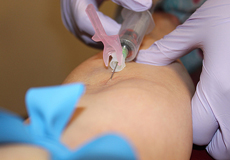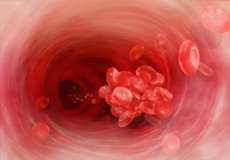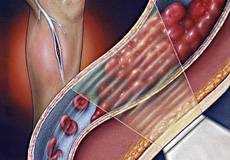Deep vein thrombosis (DVT)
There is a silent disease which can be life threatening yet in many cases is highly preventable. Deep vein thrombosis (DVT) is a condition in which a blood clot forms inside of a blood vessel or vein and either slows down or blocks the flow of blood. Two situations may arise, either the blood clot will stick to the side of the vessel and be stationary, or it will remain loose and travel through the vein to other organs in the body. This is very dangerous as the loose clot can cause blockage of the blood flow in the lungs and lead to a pulmonary embolism (PE). Left untreated, an embolism may lead to death.

Symptoms of PE include:
Sudden, sharp chest pain.
Shortness of breath.
Chest pain that gets worse with deep breathing or coughing.
Coughing up blood or pink, foamy mucus.
Rapid heart rate.
Additionally, the above symptoms may also cause sweating and increase anxiety[1].
Symptoms: Development of DVT often occurs in the legs, and frequently the upper thigh area. Painful to both movement and touch, the leg may show signs of obvious swelling caused by the pooling of blood backed up in the blocked vein. The leg may also become red and hot for the same reasons.
Causes:
 In many cases the development of blood clots can be prevented. If traveling, use of compression socks keeps the blood flowing back up to the heart and reduces the pooling of blood while sitting for long periods of time. Also those who are bedridden should have their legs elevated and massaged on regular bases to move the blood from the legs and decrease the opportunity to pool. One of the greatest risks comes post-operatively while the patient is immobilized. It is vital that patients be educated before the operation so that during the early recover period, they can pay attention to and increase efforts to move the legs and feet on a frequent and regular schedule. Also, the sooner a patient ambulates (gets up and walks) after an operation, the likelihood of forming a clot decreases significantly. For those who may need a longer period to ambulate (severe accidents or operations), use of electronic leg cuffs is critical. These devices wrap around the lower legs and are connected to a machine that sends electrical impulses causing the “cuff” to vibrate or squeeze the blood towards the upper leg and back to the heart. Patients planning surgery must discuss such issues prior to any major medical intervention.
In many cases the development of blood clots can be prevented. If traveling, use of compression socks keeps the blood flowing back up to the heart and reduces the pooling of blood while sitting for long periods of time. Also those who are bedridden should have their legs elevated and massaged on regular bases to move the blood from the legs and decrease the opportunity to pool. One of the greatest risks comes post-operatively while the patient is immobilized. It is vital that patients be educated before the operation so that during the early recover period, they can pay attention to and increase efforts to move the legs and feet on a frequent and regular schedule. Also, the sooner a patient ambulates (gets up and walks) after an operation, the likelihood of forming a clot decreases significantly. For those who may need a longer period to ambulate (severe accidents or operations), use of electronic leg cuffs is critical. These devices wrap around the lower legs and are connected to a machine that sends electrical impulses causing the “cuff” to vibrate or squeeze the blood towards the upper leg and back to the heart. Patients planning surgery must discuss such issues prior to any major medical intervention.
Diagnosis:
 Diagnosis is usually done though the use of an ultrasound. An experienced Radiologist will be able to guide the ultrasound probe to those areas most likely to have a blood clot, such as the main vein in the thigh. If this test does not provide a clear diagnosis, use of venogram may be required. The venogram is a test which utilizes a special dye which shows up on x-rays and can clearly determine the condition of the veins, their valves which prevent blood from flowing backwards, and the location of any clot. (It is necessary to mention that while these dyes are usually safe and necessary for proper diagnosis; a rare few people may have an allergic reaction to the dye. Open discussion with the Radiologist is vital).
Diagnosis is usually done though the use of an ultrasound. An experienced Radiologist will be able to guide the ultrasound probe to those areas most likely to have a blood clot, such as the main vein in the thigh. If this test does not provide a clear diagnosis, use of venogram may be required. The venogram is a test which utilizes a special dye which shows up on x-rays and can clearly determine the condition of the veins, their valves which prevent blood from flowing backwards, and the location of any clot. (It is necessary to mention that while these dyes are usually safe and necessary for proper diagnosis; a rare few people may have an allergic reaction to the dye. Open discussion with the Radiologist is vital).
Treatment:
Depending upon the results, treatment can consist of several options. The first is to provide the patient with blood thinners (anticoagulants) which will help the body to dissolve any localized clot and reduce the likelihood of further clot formation. If the clot is not attached to the side of the vein, it is necessary for a filter or mesh to be placed between the clot and the veins leading to the main organs such as lungs and brain. This removable mesh will catch the clot and keep it from moving upwards. In both cases, rest is necessary to not dislodge attached clots yet enough movement should be continued to prevent further clots from forming.
While DVT is a potentially life threatening condition, it is often preventable and manageable. Quick diagnosis and treatment will greatly reduce the severity of the situation, and offer a better prognosis. Therefore, education of the general public is highly advantageous and can help save lives. Additionally, it is vital that hospital staff themselves understand the importance of getting patients up and walking as soon as is medically allowed and to initiate use of the leg cuffs on patients who cannot ambulate early.